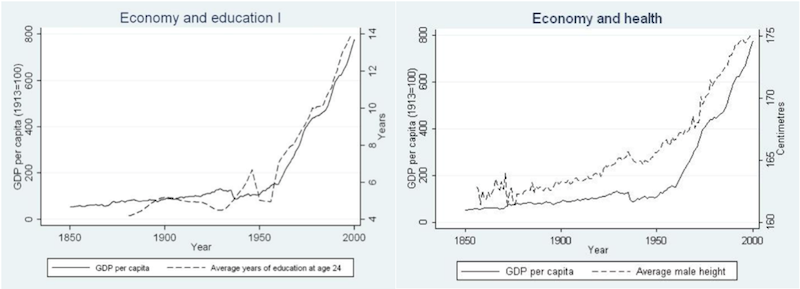It is well known by now the importance of investment in formal education – human capital accumulation, as economists refer to – in economic growth and development in current globalised economies. This strong link enables one to identify how the particularities of the education system in a country – and its changes through time – can shape the evolution of its economy through its history.
The BSE Working Paper (No. 897), “The Impact of Investment in Human Capital on Economic Development: An Empirical Exercise Based on Height and Years of Schooling in Spain (1881-1998)”, by Enriqueta Camps, investigates how the particularities of the evolution of the education system in Spain from the 19th to the 21st century affected the country’s GDP. Using data on education and individual health, she identifies how the lack of formal education in early industrial Spain did hold its economic growth in the most dynamic, modern sectors, if compared to other European countries. By the time Spain started to invest in human capital accumulation, she argues, its economy started to ‘catch up’ with its neighbouring peers, therefore starting a period of sustainable economic growth.
The taller the healthier, the more literate the more productive
The strategy by which Camps identify the weight of formal education in the growth – or decrease – of the Spanish GDP is to look at the relation of years of schooling and GDP in her series. At the same time, she also looks at the relation of average individual height and GDP, using the well accepted relation of individual height as a proxy for individual health and physical strength. As seen in Figure 1, both variables follow GDP side-by-side. At first glance, both seem to have direct positive relation with GDP variation; what is shown, instead, is that by splitting the analysis in three different historic periods of Spain provides interesting insights.

The periods analyzed by the author are from 1881-1929, 1930-1958, and 1959-1998. The first one is when Spain was still characterized as a agricultural, not industrialized country; not surprisingly showing very low levels of literacy. The second period is defined as a turbulent period of crisis and civil war. The final period is instead when Spanish democracy started to consolidate and Spain as a country finally ‘joined’ the world trend of economic integration and technological innovation.
The first exercise shows indeed that, for the first period of interest, the level of schooling has a negative association with the increase in the Spanish GDP, whereas individual height has a positive association. What explains such odd relation is indeed the low level of education quality in that period which, according to the author, was organized by the Catholic Church and focused on theological contents rather than technical learning. In fact, literacy and further skills were a sub-product of being educated at those times, she argues. On the other hand, as the Spanish economy was still a extracting economy at that time, physical strength was the major skill necessary. That is how she explains the positive relation of height and GDP growth.
Similar results are found in the second period of analysis – from 1930 to 1958, education and health are related negatively and positively to GDP growth, respectively. In that period Spain passed through a Civil War and recession in which many literate individuals were forced to emigrate, reducing the human capital stock of the country. Moreover, Camps argues that the allocation of national resources in regions of the country which were favorable to the dictatorship’s ideology, which were the most depressed in terms of economic activity, led to a misallocation of investments in human capital formation and indeed help to explain the stagnation of that period.
The final exercise is done in the period from 1959 onwards, when it turns out that both education and individual health are positively associated with economic growth. Following the democratization process, liberalization of the economy and rise in the education levels from the 60’s, the Spanish GDP rebounds from the stagnation of previous year to a consistent process of growth and human capital accumulation. Camps finds that the statistical values associated to increase in GDP as of an increase in one year of education surpasses the same value associated with individual height, and that is what enables her to conclude that human capital formation, once established as a sustainable process, becomes the main engine of economic growth and development in Spain.
From strong to healthy…and more educated
Camps analyzes historical data on health and education to identify their importance on GDP growth in Spain. Naturally, individual health – proxied by the data on average height – has a permanent positive relation with economic activity. However, what comes out of her exercise is that in earlier years of 20th century, the role of health is more related to physical strength necessary in agriculture and mining activities, predominant in that period. On the other hand, as Spain evolves into a modern, democratic and open economy, the role of individual health switches to a complement to formal education when speaking of human capital formation. That is, investment in formal education becomes the main engine in the process of human capital accumulation. Individuals, now more educated – and healthier – drive the rise of Spain as a strong economy, catching up with other OECD countries.

